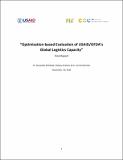Optimization-based Evaluation of USAID/OFDA Global Logistics Capacity
This collection contains the research methods, presentations, and results in the project "Optimization-based Evaluation of USAID/OFDA Global Logistics Capacity". This research was a part of the MIT Comprehensive Initiative on Technology Evaluation (CITE).
Throughout the period of performance from May 2019 to September 2020, a research team from the Massachusetts Institute of Technology's Humanitarian Supply Chain Lab worked with the Office of Foreign Disaster Response, which was merged with USAID's Food for Peace into the new Bureau of Humanitarian Assistance (BHA), to research a model, methods, inputs, and outputs to support inventory decision-making for disaster response operations. In Phase I of the project, the team understood BHAs operational processes during disaster responses and collected data and information to characterize the operations. Key results are summarized in a report for Phase I and an accompanying presentation. Phase I revealed the complexities of planning disaster response operations at BHA. The team settled on researching model support for two key operational decisions: (1) How much inventory should BHA hold in each of the four global warehouses for disaster response, and (2) How much inventory in total should BHA carry in their system? The team also aimed to support decision-making through metrics that shed light on system performance and provide easy access and comparability among options.
The team developed a stochastic linear program, relying on various data sets required for inputs, and created multiple methods to merge and extract important information relevant for modeling. The team created a model that supports strategic inventory decision-making in multiple ways. Results show that BHA can rely on the model to answer the strategic inventory allocation decisions raised above and use six key metrics to compare preparedness options: (i) Inventory balance metric, (ii) average time, (iii) average cost, (iv) % TAP served, (v) % fully served, and (vi) the inventory allocation metric.
Over the course of the project, BHA became convinced that the model can support critical decision-making. The team outlined a path towards implementing a decision-support tool and identified how a systematic decision-making process is a key prerequisite for effective implementation. Inspired by the sales & operations planning process (S&OP) used widely in the private sector, the team researched and developed a concept note for S&OP process for BHA's disaster-response-planning activities. It highlights how such planning processes, especially in conjunction with a well-defined supply chain strategy, provide the framework for developing robust decision-support tools in the future. The work also revealed multiple interesting insights into operational strategies. For example, the research team was able to show that the number of people BHA typically seeks to serve relative to the total inventory in the system effects the level of inventory consolidation that is optimal in the network. This also underlined the importance of the disaster portfolio approach and the need for an appropriate estimation of the sets of disasters in this portfolio. The research team outlined an approach for using predictive analytics to determine a forward-looking disaster portfolio.
News
Code developed to support research with USAID/OFDA/BHA is housed on Github
https://github.com/MIT-HSCL/OFDA-SLP
its main purpose was to test methods and models for improving non-food disaster response inventory allocation. It also served to test different metrics for decision-making support.
Recent Submissions
-
Data-driven optimization of OFDA's disaster response capacity: Python Source Code
(GitHub, 2020-10-01) -
Data-driven optimization of OFDA's disaster response capacity: Final Report
(2020-09-30)This final report summarizes the research methods and results in the project “Optimization-based Evaluation of USAID/OFDA Global Logistics Capacity”. This research was a part of the MIT Comprehensive Initiative on Technology ...

